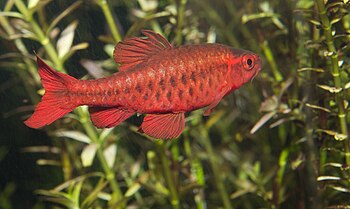 |
| Cherry barb, Puntius titteya (Photo credit: Wikipedia) |
The Cherry Barb grows to about two inches (5cm) long. The average lifespan of this fish is about four years, but some have been recorded up to seven years old.
Threatened Species
This fish is threatened in the wild. Juniper Russo Tarascio in his excellent article on Associated Content:
"The Cherry Barb: A Threatened Freshwater Aquarium Fish" puts its rarity down to overfishing for the Aquarium Trade. Although this may certainly have been a factor in the reduction in numbers of this fish, my own research suggests that the continuing problems the wild population of the Cherry barb are more to do with the destruction of habitat rather than overfishing.
In our own shop, all these species (and nearly all the fish) are bred in captivity.
Water Conditions
The Cherry Barb will be happy at a temperature of 24 degrees C (75 degrees F), with a pH of 7 and soft to moderate hardness. Nowadays, practically all the Cherry Barbs offered for sale are captive bred ones, and like many captives bred fish tend to be able to adapt to a wider range of conditions than the wild ones could. However, particularly for this fish, do not change the water temperature or chemistry too quickly.
The Tank set up should have plants, preferable growing right up to the surface, and some clear section for swimming.
Food
Like most fish, Cherry Barbs are omnivores. In the wild, they will eat insect larvae, especially the young of mosquitoes, algae, and a wide range of other things of the right size. In the aquarium, they will eat all normal fish foods and are an easy fish to feed.
Like nearly all aquarium fish, they appreciate the occasional feed of live food like daphnia or wrigglers. Good frozen foods like frozen bloodworms are a good treat.
Companions
The Cherry Barb is not a fish that forms a very tight school. Nevertheless, if only one is kept it tends to be stressed. I recommend a group of at least six.
It is one of the most peaceful barbs, and I have kept them even with slow, moving long finned fish like Siamese Fighting Fish, Guppies and Endlers Guppies.
Cherry Barbs are also happy with other small reasonably peaceful fish.
I have also kept them with slightly more aggressive fish like Paraguay Tetras, Buenos Aires Tetras, Colombian Tetras, Rosy Barbs, and Tiger Barbs, but I would hesitate to recommend these fish as companions for Cherry Barbs. I suggest caution with these fish.
Sexing
The Male Cherry Barbs are a much more definite cherry color than the females which are more faded in color. The females tend to be plumper.
Breeding
The Cherry Barb is an egg-laying species, producing something like 200 eggs from one female. This fish spawns readily. A fine-leaved plant in the breeding aquarium will increase the chances of them laying.
The eggs hatch in about one day. The parents eat their own eggs as well as the young babies, so to have much chance of raising the young, the parents need to be removed as soon as possible after spawning.
An alternative way of breeding it is simply to keep a small group of them in a large aquarium with a lot of plants, and no other fish. Under these conditions, many of the eggs and fry will get eaten, but some may survive. This is a little closer to what would happen in the wild.
Pest Fish
Although I do not have evidence that the Cherry Barb is a pest fish anywhere, any fish introduced into a foreign ecosystem can damage it. The fact that it is not common in its native area is not a good reason to put it into inappropriate places in the wild.

No comments:
Post a Comment